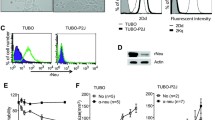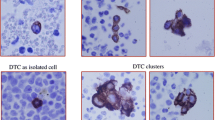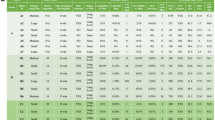Abstract
Although proto-oncogene expression has been shown to correlate with clinical outcome in breast carcinoma, an experimental model has not been proposed to study this phenomenon in vivo. In addition, the ability to modulate this proto-oncogene in vivo to correlate with phenotypic behavior has not been determined. Utilizing an intraperitoneal model for metastatic spread with BT20 human breast carcinoma cells, clonally expanded cells expressing five fold higher c-fms protein were compared with parent BT20 cells as well as an underexpressing clone using intrasplenic injection following left flank cut-down in female nude and Severe combined immunodeficient (SCID) mice. Athymic BALB/c nude and SCID animals were observed for clinical evidence of tumorigenicity with necropsy performed at either 50 or 80 days unless compromised earlier. Immunohistochemistry (IHC) of the harvested tumors was performed to correlate c-fms expression from its original in vitro culture to the in vivo model. At day 50, differences in primary tumor take and spread to the pelvis were already evident favoring the c-fms over-expression group with IHC of these tumors revealing significantly higher intensity of staining for c-fms, (mean H score of 205 vs. 43 in the over-expression and parent groups, respectively). At day 80, tumor take and spread was comparable; however, tumor size in the over-expression group was significantly larger than the parent and under-expressing group in both the BALB/c and SCID experiments. Modulation of c-fms proto-oncogene expression was also achieved using the anti-glucocorticoid, RU-486, via oral administration to SCID mice with subsequent correlation to IHC staining. This model thus provides tumors of significant size and organ diversity which retain their phenotype early in tumorigenesis allowing an early endpoint to assess efficacy of novel treatments.
Similar content being viewed by others
Abbreviations
- IHC:
-
immunohistochemistry
- SCID:
-
severe combined immunodeficient
References
KA Marshall A Redfern B Cady (1974) ArticleTitleLocal recurrences of carcinoma of the breast Surg Gynecol Obstet 139 IssueID3 406–8 Occurrence Handle4853027
InstitutionalAuthorNameCancer Facts and Figures (2002) American Cancer Society Yearly Publication American Cancer Society Atlanta, GA
BM Kacinski D Carter K Mittal et al. (1988) ArticleTitleHigh level expression of fms proto-oncogene mRNA is observed in clinically aggressive human endometrial adenocarcinomas Int J Radiat Oncol Biol Phys 15 823–9 Occurrence Handle3182322
BM Kacinski ER Stanley D Carter et al. (1989) ArticleTitleCirculating levels of CSF-1 a lymphohematopoietic cytokine may be a useful marker of disease status in patients with malignant ovarian neoplasms Int J Radiat Onc Biol Phys 17 159–64
BM Kacinski KA Scata D Carter et al. (1991) ArticleTitleFMS (CSF-1 receptor) and CSF transcripts and protein are expressed by human breast carcinomas in vivo and in vitro Oncogene 6 941–52 Occurrence Handle1829808
SK Chambers BM Kacinski CM Ivins ML. Carcangiu (1997) ArticleTitleOverexpression of epithelial macrophage colony-stmulating factor (CSF-1) and CSF-1 receptor: A poor prognostic factor in epithelial ovarian cancer, contrasted with a protective effect of stromal CSF-1 Clin Cancer Res 3 999–1007 Occurrence Handle9815777
MG Maher E Sapi B Turner et al. (1998) ArticleTitlePrognostic significance of colony-stimulating factor receptor expression in ipsilateral breast cancer recurrence Clin Cancer Res 4 IssueID8 1851–6 Occurrence Handle9717811
SK Chambers Y Wang M Gilmore-Hebert BM. Kacinski (1994) ArticleTitlePost-transcriptional regulation of c-fms proto-oncogene expression by dexamethasone and of CSF-1 in human breast carcinomas in vitro Steroids 59 IssueID9 514–22 Occurrence Handle10.1016/0039-128X(94)90069-8 Occurrence Handle7846733
Azodi M, Roy WJ, Chambers JT, Chambers SK. 1999. Inhibition of invasiveness and motility of ovarian and breast cancer cells by oligomer therapy directed towards the c-fms proto-oncogene. Proc Int Gynecol Cancer Soc (Abstract).
AE Filderman A Bruckner BM Kacinski N Deng HG. Remold (1992) ArticleTitleMacrophage colony-stimulating factor (CSF-1) enhances invasiveness in CSF-1 receptor-positive carcinoma cell lines Cancer Res 52 IssueID13 3661–66 Occurrence Handle1535551
JE. Price (1996) ArticleTitleMetastasis from human breast cancer cell lines Br Cancer Res 39 93–102 Occurrence Handle10.1007/BF01806081
BC Giovanella DM Varademan LJ Williams et al. (1991) ArticleTitleHeterotransplantation of human breast carcinomas in nude mice. Correlation between successful heterotransplants, poor prognosis and amplification of the HER-2/NEU oncogene Int J Cancer 47 66–71 Occurrence Handle1985881
E Sapi MB Flick S Rodov et al. (1996) ArticleTitleIndependent regulation of invasion and anchorage-independent growth by different autophosphorylation sites of the macrophage colony-stimulating factor 1 receptor Cancer Res 56 5704–12 Occurrence Handle8971179
JE Price LM Daniels Campbell R. Giavazzi (1989) ArticleTitleOrgan distribution of experimental metastases of human colorectal carcinoma injected in nude mice Clin Exp Metast 7 IssueID1 55–8 Occurrence Handle10.1007/BF02057181
S Takahashi L. Biempica (1985) ArticleTitleEffects of vitamin A and dexamethasone on collagen degradation in mouse mammary adenocarcinoma Cancer Res 45 3311–21 Occurrence Handle2988767
IM Hunneyball MJ Crossley M. Spowage (1986) ArticleTitlePharmacological studies of antigen-induced arthritis in BALB/c mice: Characterization of the arthritis and the effects of steroidal and non-steroidal anti-inflammatory agents Agents Actions 18 IssueID34 384–93 Occurrence Handle10.1007/BF01965002 Occurrence Handle3751751
KS McCarty SuffixJr LS Miller EB Cox et al. (1985) ArticleTitleEstrogen receptor analyses. Correlation of biochemical and immunohistochemical methods using monoclonal receptor antibodies Arch Pathol Lab Med 109 716 Occurrence Handle3893381
K Cornetta A Moore M Johannessohn G.W. Sledge (1994) ArticleTitleClonal dominance detected in metastases but not primary tumors of retrovirally marked human breast carcinoma injected in nude mice Clin Exp Metast 12 IssueID1 3–12 Occurrence Handle10.1007/BF01784328
L Ozello M. Sordat (1986) ArticleTitleBehavior of tumors produced by transplantation of human mammary cell lines in athymic nude mice Eur J Cancer 16 553–59
JE Price A Polyzos RD Zhang LM. Daniels (1990) ArticleTitleTumorigenicity and metastasis of human breast carcinoma cell lines in nude mice Cancer Res 50 717–721 Occurrence Handle2297709
DR Sorensen M Leirdal M. Sioud (2003) ArticleTitleGene silencing by systemic delivery of synthetic siRNAs in adult mice J Mol Biol 327 IssueID4 761–6 Occurrence Handle10.1016/S0022-2836(03)00181-5 Occurrence Handle12654261
Author information
Authors and Affiliations
Corresponding author
Rights and permissions
About this article
Cite this article
Toy, E.P., Bonafé, N., Savlu, A. et al. Correlation of tumor phenotype with c-fms proto-oncogene expression in an in vivo intraperitoneal model for experimental human breast cancer metastasis. Clin Exp Metastasis 22, 1–9 (2005). https://doi.org/10.1007/s10585-005-0718-4
Received:
Accepted:
Issue Date:
DOI: https://doi.org/10.1007/s10585-005-0718-4




